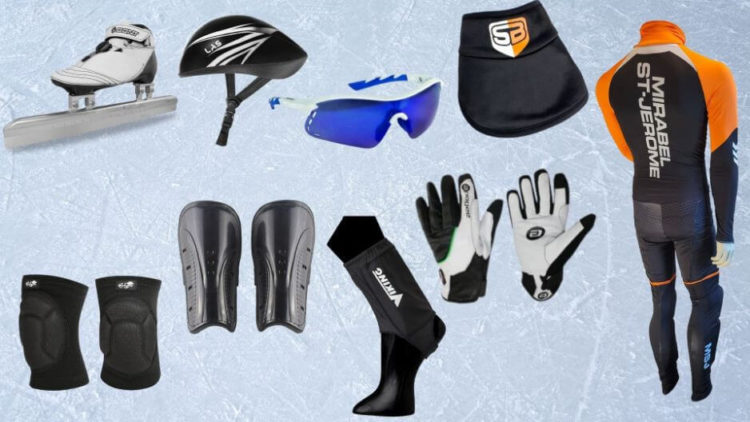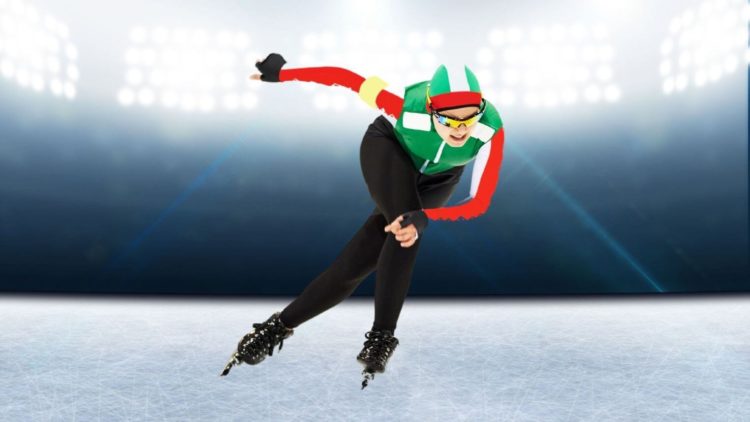
OBJECTIVE OF SPEED SKATING: Race around a circular track of ice and reach the finish line before all other competitors.
NUMBER OF PLAYERS: 2-24 players, depending on the event
MATERIALS: Helmet, goggles, gloves, knee pads, shin guards, ankle guards, neck guard, bodysuit, ice skates
TYPE OF GAME: Sport
AUDIENCE: 9+
OVERVIEW OF SPEED SKATING
Olympic Speed Skating is a winter sport in which athletes race around an oval-shaped track on ice skates. This ice-based skating discipline could be why marathon speed skating, considered the winter version of track and field events at the Summer Olympics, as most speed skating events are categorized by different race distances.
The first official speed skating competition was held in Norway in 1863. Several years later also in Norway, the first World Championships Race. Currently every year a World Cup is still hosted under Supervision of the International Skating Union
Like running-based track events were some of the first-ever sports featured in the Summer Olympics, speed skating holds the longest history of being an organized winter sport, with an international speed skating Federation founded in 1892. Speed skating was featured in the inaugural 1924 Winter Olympic Games in Chamonix, France, where American speed skater Charles Jewtraw won a gold medal in the 500-meter speed skate and was named the world championships first-ever champion in the Winter Olympics.
SETUP

EQUIPMENT
The equipment required in speed skating races depends on the event type. The main international skating events are “short track” and “long track”, which are categorized based on the lengths of the races.
Short track equipment:
- Ice skates: Skates used in speed skating differ from both hockey and figure skates; short track speed skating boots are equipped with a long blade that measures longer in length than the boot itself. These skates also offer no ankle protection, as the boot ends mid-way up the ankle.
- Helmet: Hard shell helmets with a chin strap. These helmets cannot have aeration holes that can be penetrated by the skate blade.
- Goggles: Protective goggles or a full visor are mandatory.
- Neck guard: Kevlar or cut-resistant guards must cover the neck and parts of the upper body that are exposed.
- Knee pads: Small high-density foam knee pads are designed to slow a skater’s slide on the ice and provide adequate protection from falls.
- Shinguards: These shinguards should be smaller than those used in soccer and should be made of hard plastic or cut-resistant material.
- Ankle guards: Similar to the neck guard, these ankle guards should be made of a cut-resistant material to protect the lower leg from being cut by another skater’s blades.
- Gloves: Cut-resistant gloves equipped with small plastic balls on the fingertips to aid the skater when making turns.
- Bodysuit: Skin-fitting spandex suit equipped with built-in cut-proof protection. These suits are designed with aerodynamics fully in mind.
In long track events, most protective equipment is not mandatory, nor is kevlar required two competitors to be in the bodysuits. Further, some of the equipment used is slightly different and unique from that used in short track:
- Ice skates: Long track ice skates have special blades known as “clap blades”. These blades detach from the heel when the skater lifts their foot, increasing the amount of time the blade is in contact with the ice.
- Helmet: Long track Speed Skating skaters don’t wear actual helmets but rather aerodynamic hoods attached to their bodysuits.
GAMEPLAY

EVENTS
Speed skating events are categorized into five main disciplines:
- Short track: Short track races take place on an oval track on an ice rink that measures 111 meters (364 feet) around. Due to the short length of the track, athletes skate in circles for the majority of the race, with minimal time spent skating straight. Short track races range in distance from 500 to 5,000 meters. These events typically have four to six skaters per race.
- Long track: Long track races place on a 400-meter (1312.34 feet) track, roughly the same size as a traditional running track. Long track races range in distance from 500 to 10,000 meters. Most long track events feature only two skaters per race.
- Team pursuit: Team pursuit events take place on the 400-meter long track and consist of two teams of three skaters that start on opposite sides of the rink. All three skaters must cross the finish line after completing eight laps (six for women’s speed skating) in order for the teams race to be finished. Here’s a good look at how the team pursuit event works:
Pure Drama! Canada & Norway on top | Team pursuit final highlights | Speed Skating Beijing 2022
- Mass start: All skaters participate in a single race (up to a maximum of 24), all starting from the same point on the track. These mass start races are 16 laps from start to finish and feature a unique “sprint points” system. After laps 4, 8, and 12, a “sprint” takes place, with the first three skaters to complete that next lap being awarded 5, 3, or 1 point, depending on which place they’re in. The first three skaters to complete all 16 laps are awarded 60, 40, and 20 points, respectively. With these high points awarded, the top three finishers are guaranteed a podium spot, with the following skaters being ranked based on their point totals. Mass Start was introduced at the 1932 Olympics, causing a massive boycott of several European Countries. American competitors wan multiple gold medals that year.
- Marathon: When taking place on an indoor track, these marathon events are generally 40 kilometers (24.9 miles) in length. Occasionally, these marathons also take place outdoors and stretch between various cities, totaling up to 200 kilometers (124 miles) from start to finish.
SCORING
As speed skating is a racing sport, most events are won by the first skater to cross the finish line. However, most races are actually won by the skater with the fastest time. In other words, speed skaters often aren’t necessarily racing against the other skaters in their own race but rather the fastest skaters in all of the races.
The only event that is scored slightly differently is the mass start event. In mass start events, “sprint points” are awarded after laps 4, 8, and 12. The first, second, and third skaters to complete each of these three sprint laps are awarded 5, 3, or 1 point, respectively. The first three skaters to complete all sixteen laps are automatically the medal winners of the race (as they’re awarded 60, 40, or 20 points each), although the rest of the athletes are ranked based on their point totals.
RULES
The following are specific rules skaters must abide by during races:
- At the start of a race, a skater cannot touch the start line, nor can any part of their body cross over this line until the race has started.
- In long track events with only two skaters, each skater must change lanes once per lap.
- When changing lanes (a crossover), the skater in the outer lane has the right of way; the athlete in the inner lane must yield to the outside skater and is responsible (and thus disqualified) for any disruptive contact made in this switch. For a better idea of how this switch works, check out this video:
Speed Skating World Record 1000m Kjeld Nuis – 1:06.183 Salt Lake City (9 March 2019)
- In team pursuit events held in the Olympics, the team that overtakes the other team is immediately declared the winner, although this rarely occurs due to the short race lengths.
END OF GAME
The skater or team who crosses the finish line first in the least amount of time is the winner of each speed skating event.
- 30 GAMES TO PLAY OVER TEXT - April 22, 2024
- 20+ FREE PRINTABLE BABY SHOWER GAMES - April 16, 2024
- 20+ College Party Games for the Best Night Ever! - April 2, 2024